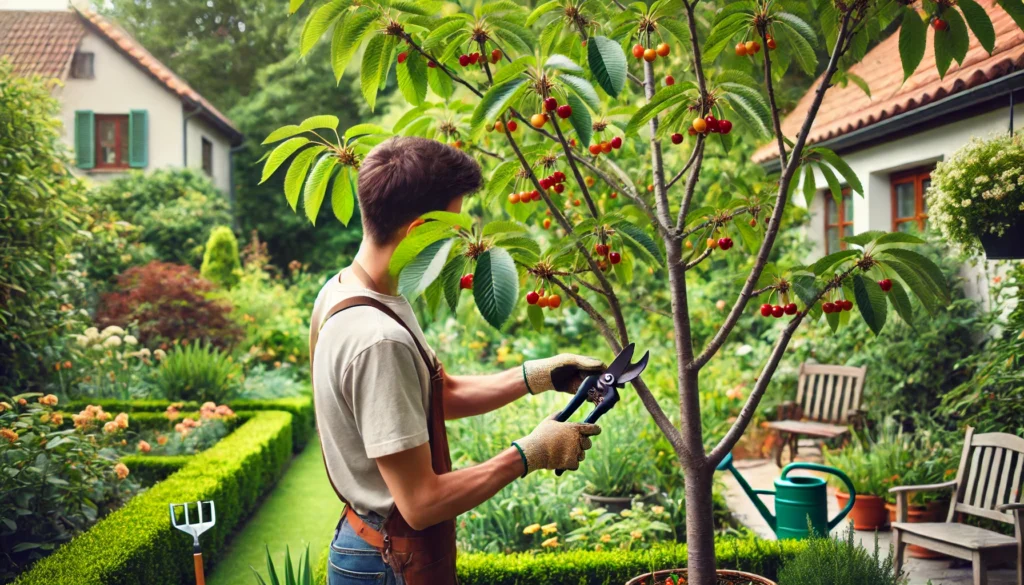
The Secret to Healthy Cherry Tree Pruning: Tips from Experts for Best Results
Pruning your cherry tree might seem like a simple task, but there’s an art to it that can drastically improve its health, fruit production, and overall beauty. If done incorrectly, you could risk damaging the tree or stunting its growth. But fear not—The Secret to Healthy Cherry Tree Pruning: Tips from Experts will reveal the essential techniques and insights to help your cherry tree thrive year after year. Whether you’re a seasoned gardener or a beginner, the expert tips we’ll share will ensure your tree remains vibrant and productive through every season. Let’s unlock the secrets to successful cherry tree care!
Table of Contents
ToggleWhy Pruning Cherry Trees is Essential 
Pruning cherry trees is a key part of maintaining their health, shape, and productivity. Regular pruning ensures your tree thrives year after year. Here’s why it’s essential:

1. Promotes Healthy Growth 
Pruning helps remove dead or diseased branches, allowing the tree to focus energy on healthy growth. This improves the overall strength and vitality of your cherry tree.
2. Increases Fruit Production 
By thinning out crowded branches, you improve airflow and sunlight exposure, leading to better fruit production. Pruning also encourages the tree to produce larger, juicier cherries.
3. Prevents Disease 
Pruning removes infected or damaged parts of the tree, reducing the risk of disease spread. It also helps the tree heal faster by improving air circulation and reducing moisture buildup.
4. Improves Tree Shape 
Regular pruning helps maintain a balanced shape, making it easier to harvest fruit and preventing the tree from growing too tall or wide. A well-shaped cherry tree is not only healthier but also looks great in your garden!
5. Encourages Stronger Branches 
Pruning weak or spindly branches allows the tree to focus on producing stronger, more robust limbs. This makes the tree more resistant to wind and storm damage.
By incorporating proper pruning techniques, you’ll ensure your cherry tree stays healthy, productive, and beautiful!
Best Time to Prune Cherry Trees 
Pruning your cherry tree at the right time is crucial for its health and productivity. Here’s the best timing for pruning to ensure strong growth and abundant fruit:
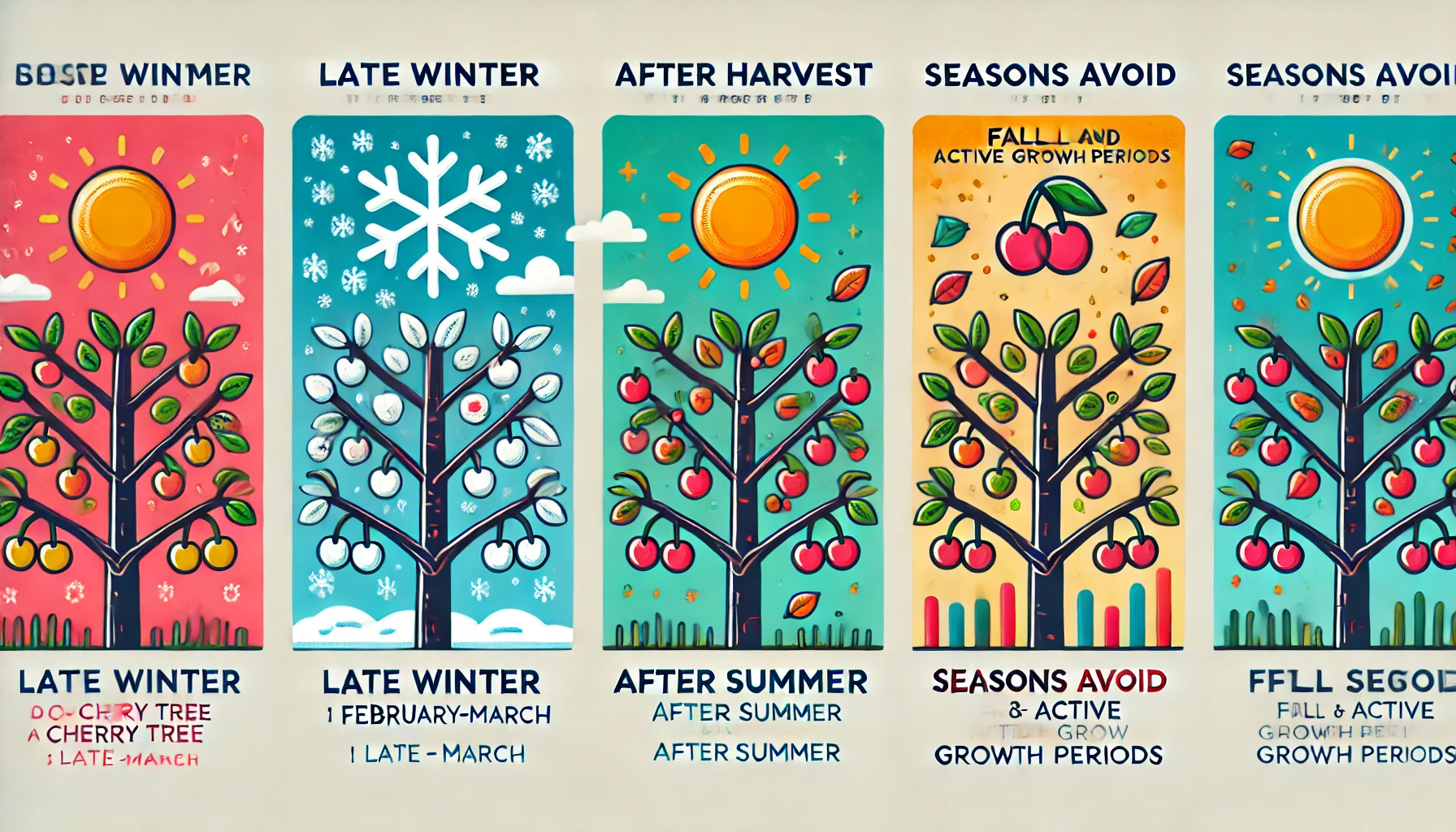
1. Late Winter to Early Spring 
The ideal time to prune cherry trees is during late winter or early spring, before new growth begins. This is typically from February to March. Pruning during this time helps your tree heal faster, encourages strong spring growth, and minimizes the risk of disease.
2. After Harvest 
If you missed pruning in winter, the next best time is right after the fruit is harvested, typically in late summer. This allows the tree to focus on regrowth without the stress of carrying fruit, and helps remove any dead or diseased branches.
3. Avoid Pruning in Fall 
Avoid pruning cherry trees in the fall, as it can stimulate new growth that is vulnerable to frost damage. Late pruning can also weaken the tree, making it more susceptible to winter stress.
4. Avoid Pruning During Active Growth 
Don’t prune cherry trees while they’re actively growing, typically in late spring or summer. Pruning during this time can cause excessive sap loss and stress the tree, hindering its growth.
Pruning at the right time ensures that your cherry tree stays healthy, productive, and ready to thrive each season!
The Tools You’ll Need 
To care for your cherry tree, having the right tools is essential for successful growth and maintenance. Here’s a list of must-have tools that will make your cherry tree care easier:
1. Pruning Shears 
A good pair of sharp pruning shears is crucial for trimming branches and removing deadwood. Regular pruning encourages healthy growth and improves air circulation around the tree.

2. Watering Can or Hose 
Cherry trees need consistent watering, especially in dry periods. Use a watering can with a long spout or a hose with a gentle spray nozzle to ensure even watering at the base of the tree. Avoid wetting the leaves to prevent disease.
3. Soil Tester 
A soil tester helps you monitor the pH level and nutrient content of the soil. Cherry trees prefer slightly acidic soil, so testing and adjusting the soil pH can improve tree health and fruit yield.
4. Mulch and Compost 
Mulching around the base of your cherry tree retains moisture, suppresses weeds, and improves soil quality. Use organic mulch like wood chips or compost to keep your tree’s roots protected and nourished.
5. Ladder 
If you have a tall cherry tree, a sturdy ladder will help you reach high branches for pruning, harvesting, or inspecting the tree. Always use a ladder with a secure base to ensure safety.
6. Fertilizer Spreader 
If you need to apply fertilizer, a spreader ensures even coverage of nutrients around the tree’s root zone. This tool helps promote strong growth and fruit production, especially when used with organic fertilizers.
7. Pest Control Sprayer 
For dealing with pests, a pest control sprayer can be used to apply organic treatments like neem oil or insecticidal soap. This is especially helpful during the growing season when pests can quickly damage your tree.
With these tools, you’ll be well-equipped to care for your cherry tree and ensure it thrives for years to come. Happy gardening!
How to Prune Your Cherry Tree: Step-by-Step Guide 
Pruning your cherry tree is essential for maintaining its health, shape, and fruit production. Follow this simple, step-by-step guide to ensure your tree thrives:
1. Choose the Right Time 
The best time to prune your cherry tree is during late winter or early spring before new growth begins. This minimizes stress and helps the tree heal faster.
2. Gather Your Tools 
You’ll need:
- Sharp pruning shears
- A pruning saw (for larger branches)
- Gloves
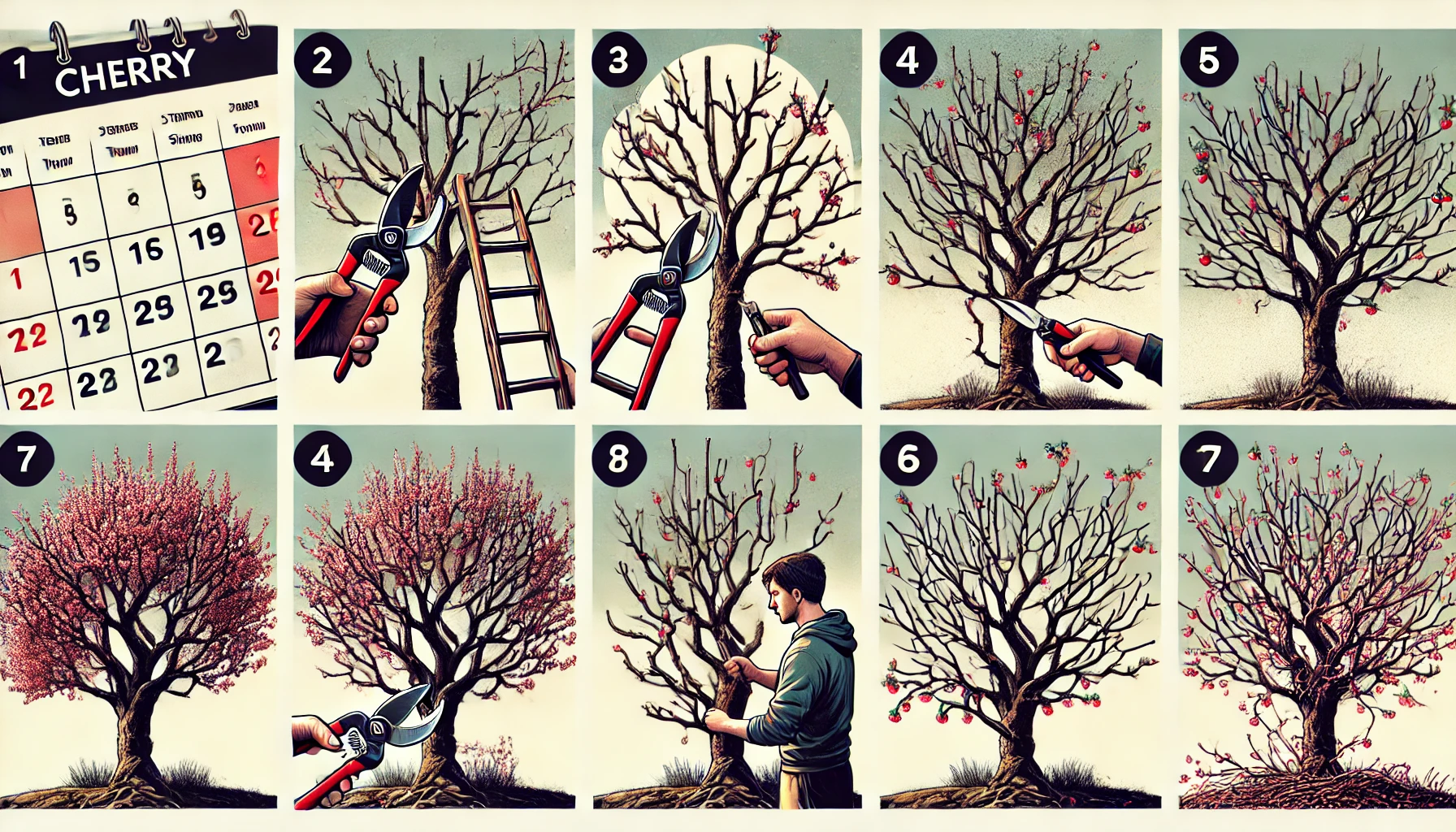
3. Start with Dead or Damaged Branches 
Remove any dead, diseased, or broken branches first. This prevents the spread of disease and encourages healthy growth.
4. Thin Out the Center 
For better airflow and sunlight penetration, remove any inward-growing or crossing branches. This helps reduce the risk of fungal infections and promotes better fruit development.
5. Cut Back the Longer Branches 
Trim back any long, straggly branches to shape your tree. Aim to maintain a balanced canopy with a central leader (main trunk) and strong side branches.
6. Remove Suckers and Water Sprouts 
Suckers (growth from the base) and water sprouts (vertical shoots) steal energy from the tree. Remove these to encourage healthier growth.
7. Prune for Shape 
Shape your tree to maintain a well-spread, open structure. Focus on keeping the tree balanced and preventing overcrowding. This helps with fruit production and ease of harvesting.
8. Clean Up 
After pruning, clean your tools with rubbing alcohol to prevent the spread of disease. Dispose of any cuttings properly.
By following these steps, your cherry tree will stay healthy, productive, and beautiful for years to come!
Expert Tips for Pruning Cherry Trees Like a Pro 
Pruning your cherry tree is essential for promoting healthy growth, preventing diseases, and maximizing fruit production. Here are expert tips to help you prune like a pro:
1. Timing is Key 
Prune your cherry tree in late winter or early spring, while it’s still dormant. This helps avoid the spread of disease and encourages strong new growth when the growing season begins.
2. Use Clean, Sharp Tools 
Always use clean, sharp pruning shears or saws to make clean cuts. This reduces the risk of infection and ensures the cuts heal quickly.
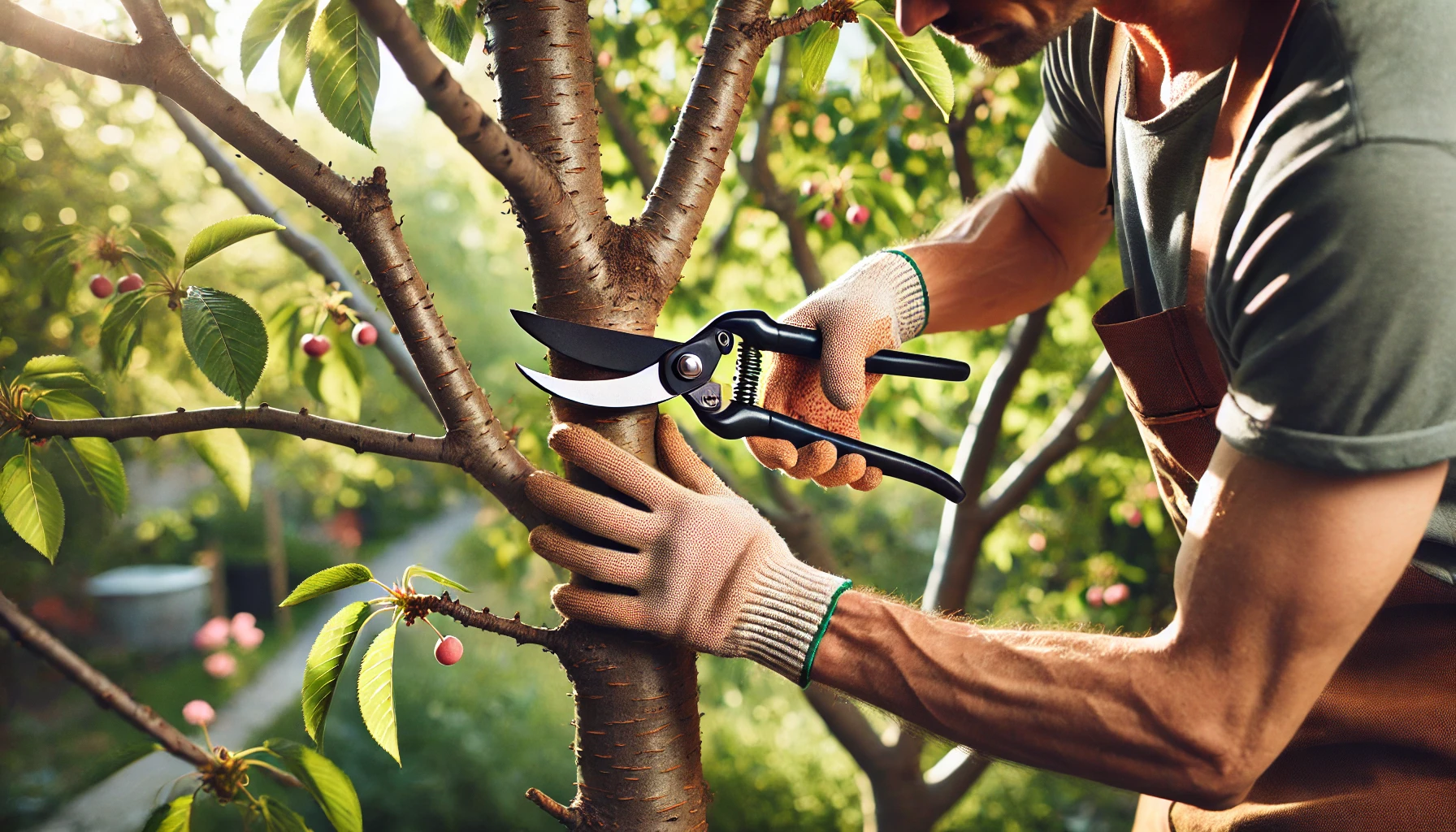
3. Remove Dead or Diseased Wood 
Start by cutting away any dead, damaged, or diseased branches. This will not only improve the tree’s appearance but also help prevent the spread of pathogens.
4. Thin the Center for Better Airflow 
Cherry trees need good airflow to prevent fungal diseases. Thin out the center branches to allow light and air to reach the interior of the tree. Focus on removing any inward-growing branches.
5. Shape the Tree 
Shape your cherry tree to create a strong, open framework. Remove any crossed or rubbing branches and maintain a central leader (the main trunk) for balance and stability.
6. Cut at the Right Angle 
Always make cuts at a slight angle to prevent water from collecting on the wound, which can lead to rot. Make sure each cut is just above a bud or lateral branch.
7. Don’t Over-Prune 
Avoid removing too many branches, especially on older trees. Over-pruning can stress the tree, reduce fruit yield, and open it up to pests. Keep pruning to a minimum, focusing on essential cuts.
With these expert tips, your cherry tree will thrive, producing more fruit and looking beautiful all year round!
Common Mistakes to Avoid 
Avoiding common mistakes is key to keeping your cherry tree healthy and thriving. Here are the top mistakes to watch out for:
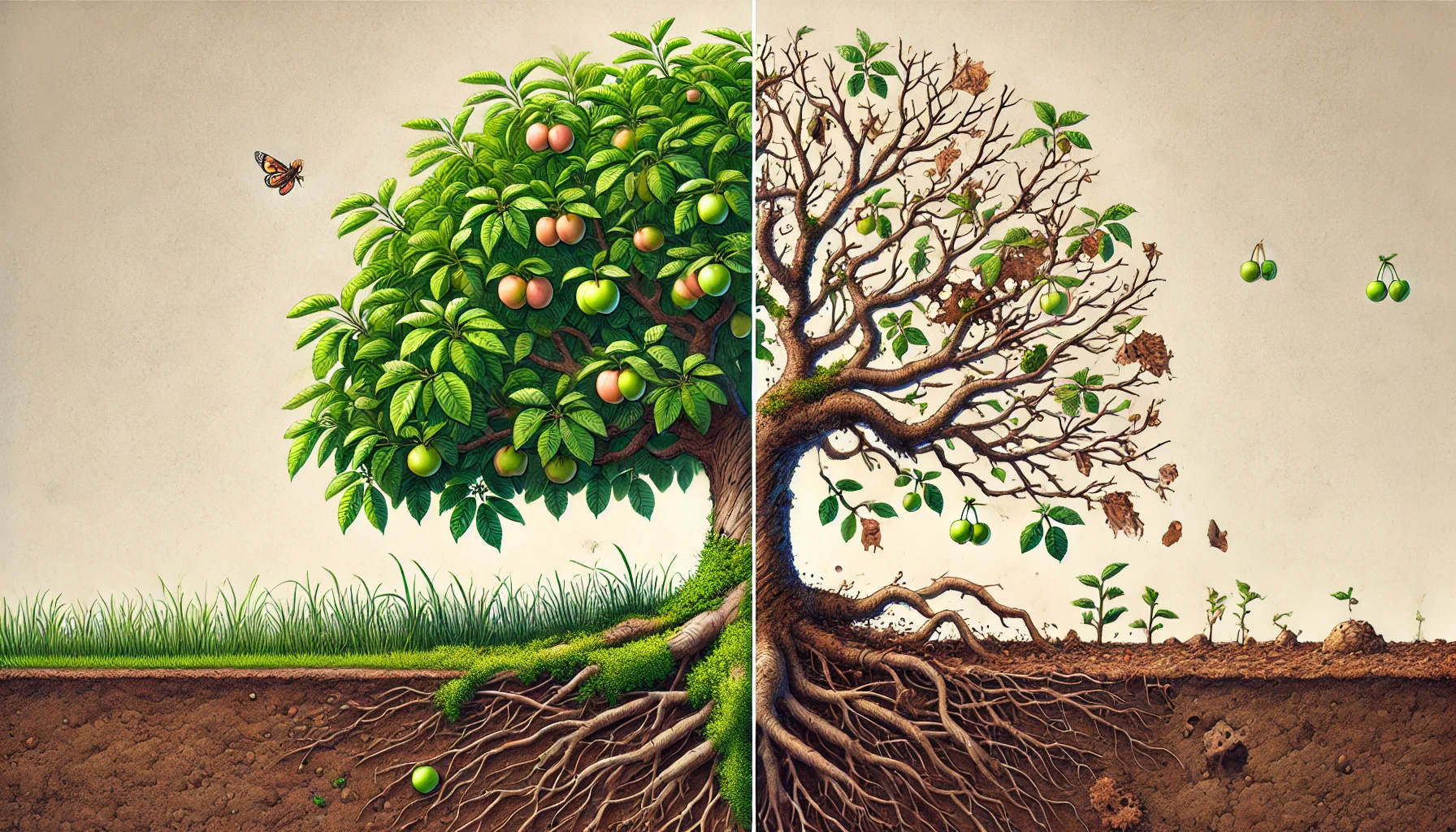
1. Planting in Poor Soil 
Cherry trees need well-draining, fertile soil. Planting in compacted, clay-heavy, or poorly draining soil can lead to root rot and poor growth. Always test your soil and amend it with organic matter to improve its texture and drainage.
2. Incorrect Watering 
Both overwatering and underwatering can stress your cherry tree. Too much water can suffocate the roots, while too little can cause dehydration. Water deeply but infrequently, aiming to keep the soil moist, not soggy.
3. Neglecting Pruning 
Cherry trees need regular pruning to remove dead or diseased wood and maintain a healthy shape. Skipping pruning can result in poor air circulation, making your tree vulnerable to disease. Prune in late winter or early spring before new growth begins.
4. Planting Too Deep 
When planting a cherry tree, make sure the root flare (where the roots meet the trunk) is level with or slightly above the soil surface. Planting too deep can restrict oxygen to the roots and stunt the tree’s growth.
5. Ignoring Pest Control 
Pests like aphids, spider mites, and cherry slugs can damage your tree. Don’t ignore early signs of infestation. Use organic pesticides or beneficial insects to control pests before they spread.
6. Choosing the Wrong Variety 
Not all cherry tree varieties are suited to every climate. Avoid varieties that are not suited for your region, as they may struggle with local pests or weather conditions. Research the best cherry tree types for your area before planting.
By avoiding these common mistakes, your cherry tree will have the best chance of flourishing!
Caring for Your Pruned Cherry Tree 
Pruning your cherry tree is essential for healthy growth and optimal fruit production. Here’s how to care for your pruned tree and ensure it thrives:
1. Watering After Pruning 
After pruning, your tree may need extra hydration to recover. Water the tree deeply to encourage strong root growth. Make sure the soil is moist but not soggy. Regular watering helps the tree heal faster.

2. Mulching for Protection 
Apply a layer of mulch around the base of your pruned cherry tree. Mulch helps retain moisture, regulate soil temperature, and prevent weed growth. Keep the mulch a few inches away from the trunk to avoid rot.
3. Monitor for Stress or Pests 
Pruned trees may be more susceptible to stress or pests. Check the tree regularly for signs of damage, like wilting or brown spots. Look for insects like aphids or caterpillars that might take advantage of the tree’s weakened state. Address any issues promptly with natural pest control methods.
4. Fertilizing for New Growth 
Give your tree a boost with balanced, slow-release fertilizer to promote healthy new growth. Apply fertilizer in early spring, just before the growing season starts, to encourage strong branches and fruit development.
5. Supporting New Growth 
After pruning, your cherry tree may produce new shoots and branches. Support these growing areas with proper staking or guiding. Avoid overcrowding branches to ensure proper airflow and sunlight, which reduces the risk of disease.
6. Re-pruning If Necessary 
Sometimes, a tree needs additional pruning after its first cut. If new growth is too dense or certain branches are growing in awkward directions, prune them back carefully to maintain shape and balance.
By following these steps, you’ll help your pruned cherry tree recover quickly and grow healthy, strong, and productive!
Conclusion 

Pruning your cherry tree the right way is an essential step in ensuring it remains healthy, strong, and productive. By following The Secret to Healthy Cherry Tree Pruning: Tips from Experts, you now have the knowledge to make informed decisions about when and how to prune. Remember, it’s not just about cutting branches—it’s about shaping the future of your tree. With the right tools, techniques, and timing, your cherry tree will thank you with vibrant growth and delicious fruit.

Be patient and consistent with your pruning efforts, and over time, you’ll see your tree thrive. Happy pruning, and here’s to a flourishing cherry tree in your garden!
Frequently Asked Questions(FAQ)
Why is pruning important for my cherry tree?
Pruning helps maintain the health of your cherry tree by removing dead or diseased branches, improving air circulation, and encouraging new growth. Proper pruning also enhances fruit production, allowing for better sunlight exposure and stronger, more productive branches.
When is the best time to prune my cherry tree?
The ideal time to prune your cherry tree is during the late winter or early spring, when the tree is still dormant. Pruning at this time helps reduce stress on the tree and encourages new growth as the weather warms up.
What tools do I need for cherry tree pruning?
You’ll need pruning shears for small branches, a pruning saw for thicker branches, gloves to protect your hands, and possibly loppers for more precision. Ensure your tools are sharp and sterilized to avoid causing harm to the tree.
How do I avoid damaging my cherry tree while pruning?
To avoid damage, always make clean cuts at a slight angle and never cut more than a third of the tree’s canopy in a single session. Focus on removing dead, diseased, or overcrowded branches to encourage healthy growth. Don’t prune too late in the fall, as this can make the tree more susceptible to winter injury.
Should I prune the cherry tree every year?
Yes! Regular pruning, ideally once a year, helps maintain the shape of the tree, keeps it healthy, and encourages strong fruit production. Avoid heavy pruning during the fruiting season to preserve the current year’s harvest.
Can I prune my cherry tree if it’s not fruiting well?
Yes, if your cherry tree isn’t producing as expected, pruning can help. Focus on thinning the canopy to allow more sunlight in and remove any damaged or weak growth. This should promote better fruiting in the next season.
What are the signs that my cherry tree needs pruning?
Signs that your cherry tree needs pruning include overgrowth, dead or diseased branches, or branches that are crossing each other. If the tree’s shape is becoming unbalanced or if there’s poor airflow in the canopy, it’s time to prune.
Is it safe to prune a cherry tree myself?
Yes, pruning a cherry tree is manageable for most gardeners, especially if you follow proper techniques. Just be sure to use the right tools, take your time, and don’t overdo it. If you’re uncertain about major cuts, consider consulting a tree care professional.


